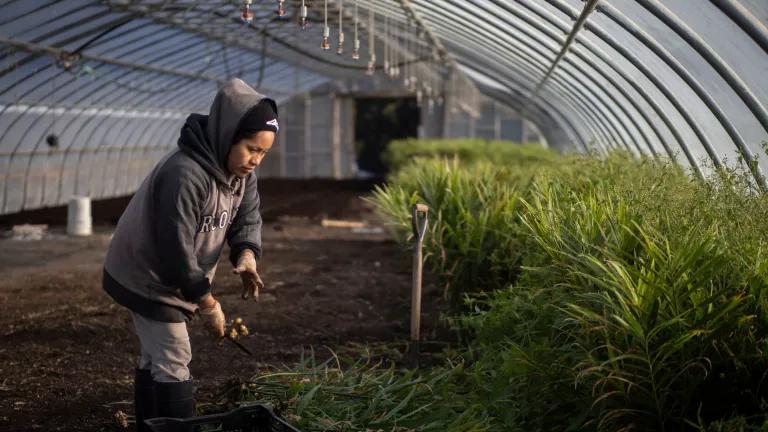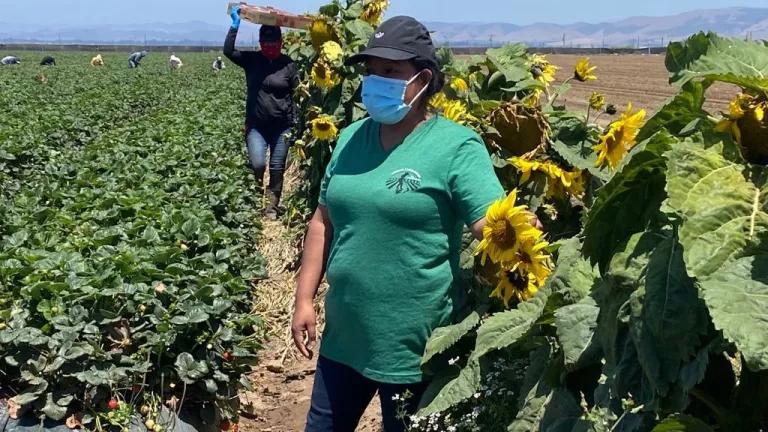EPA: Toxic Pesticide on Fruits, Veggies Puts Kids at Risk

Fruits and vegetables are a nutritious and essential part of a healthy diet for kids and pregnant women. Unfortunately, the United States Environmental Protection Agency (EPA) has found that residues from the toxic pesticide chlorpyrifos are lurking on many of these foods—at levels up to 14,000 percent higher than the “safe” limits.
Significant science shows that exposures to low levels of chlorpyrifos in early life can lead to increased risk of learning disabilities including reductions in IQ, developmental delay, autism, and ADHD.
The EPA proposed to ban chlorpyrifos from use on food more than a year ago, primarily on the basis of drinking water contamination concerns, which came about as a result of a 2007 petition by NRDC and others. Since then, new studies of the impacts of chlorpyrifos on human health have indicated that much smaller concentrations of the pesticide than previously believed—levels found on many common fruits and vegetables that women and children across the U.S. eat every day—are dangerous.
This new analysis also raises extreme concerns about risks to agricultural communities from the pesticide drifting off of crops into neighboring schools and homes, and to the general population from chlorpyrifos residues on food.
NRDC, scientists, and public health experts have been pressing EPA for nearly a decade to consider the science showing impacts to children from use of chlorpyrifos on food crops. But EPA has been dragging its feet on taking action. Meanwhile the chemical industry is pushing hard for the government not to ban the dangerous pesticide.
Now the agency is under a court-ordered deadline to take final action on the proposed ban by March 31. With the public comment period on the proposed ban ending next week and the Trump administration being sworn in days later, we are urging EPA to stand on the side of children and families—not powerful chemical corporations.
Chlorpyrifos, fruit and kids: What the science shows
In November 2016 EPA released a new chlorpyrifos target risk level to protect the developing brains and nervous systems of children. When EPA compared the new target risk level to the amounts of chlorpyrifos residues on fruits and vegetables regularly consumed by women and children, they found that the residues are unsafe. The analysis found huge exceedances of the target risk level—up to 14,000%!

Source: US EPA 2016 Chlorpyrifos Revised Human Health Risk Assessment for Registration Review, Steady State (21-day) food-only exposure estimates (at 99.9th percentile)
The amount of chlorpyrifos residue consumed by one person in a day can add up quickly, because (as shown in the table below) many different kinds of fruits contain these residues. Fruits that are big favorites for kids like apples, peaches, oranges and strawberries are widely grown using chlorpyrifos, resulting in residues on the fruit. Chlorpyrifos residues are found on these fruits even after they are washed and peeled (in the case of citrus and melons). Residues are routinely found even on fruits that are not heavily treated with chlorpyrifos in the U.S., due to high consumption of imported fruits, like peaches, grapes, and melons.
Chlorpyrifos use and residues on fruit consumed by children
|
Fruit |
Percent of whole fruit (not juice) in kids’ diets* |
Chlorpyrifos residue detected** |
Percent of US crop treated with chlorpyrifos** |
|
Apples |
36% |
Yes |
55% |
|
Peaches/nectarines |
7% |
Yes |
25%/10% |
|
Citrus |
9% |
Yes |
Oranges - 20% |
|
Berries |
8% |
Yes |
Strawberries - 20% |
|
Grapes |
5% |
Yes |
10% |
|
Melons |
11% |
Yes |
<2.5% |
Table shows fruits commonly consumed by children, detection of chlorpyrifos residues by the U.S. Department of Agriculture Pesticide Data Program testing, and the percent of the U.S. crop treated with chlorpyrifos. Sources: *Herrick et al. 2015. Fruit Consumption by Youth in the United States. Pediatrics; **US EPA 2014. Chlorpyrifos Acute and Steady State Dietary (Food Only) Exposure Analysis to Support Registration Review. Residue testing is on washed and peeled (as applicable) fruit.
In addition to fruit, growers use chlorpyrifos on a variety of vegetables and nuts, and people living, working, and attending school nearby can be exposed to the toxic pesticide when it drifts away from fields in air and dust. The table below shows that California and Washington crops that top the list for heavy use of chlorpyrifos. Studies conducted in communities living near these fields have found extensive contamination in the air, people’s homes, and even the bodies of pregnant women and children.
Top U.S. crops treated with chlorpyrifos
|
Crop |
Percent of crop treated |
Top state producer |
|
Apples |
55 |
Washington |
|
Broccoli |
45 |
California |
|
Walnuts |
45 |
California |
|
Asparagus |
40 |
California |
|
Cauliflower |
40 |
California |
|
Lemons |
35 |
California |
|
Cherries |
30 |
Washington |
|
Pecans |
30 |
Georgia |
|
Almonds |
25 |
California |
|
Peaches |
25 |
California |
Table shows U.S crops where 25% or greater is treated with chlorpyrifos and the top state producer for each. Source: USEPA 2014. Chlorpyrifos Acute and Steady State Dietary (Food Only) Exposure Analysis to Support Registration Review
Based on EPA’s recent findings, it must move quickly to protect the food supply and finalize the ban on food uses proposed last year. We cannot afford to wait. You can submit a comment to EPA in support of the ban here.
In the meantime, the best way to protect your kids is to go organic as much as possible when you’re pregnant or feeding kids in the house. (When shopping on a budget, this guide can help you make the best choices to avoid harmful residues.)



